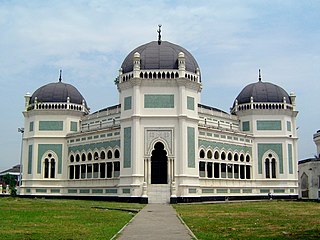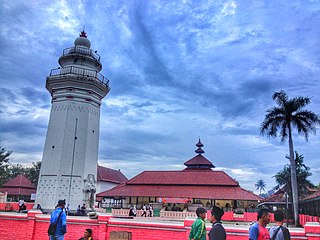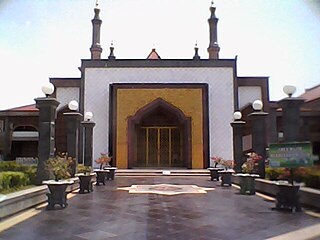
Istiqlal Mosque in Jakarta, Indonesia is the largest mosque in Southeast Asia and the ninth largest mosque in the world in terms of worshipper capacity. Built to commemorate Indonesian independence, this national mosque of Indonesia was named "Istiqlal", an Arabic word for "independence". The mosque was opened to the public on 22 February 1978. Within Jakarta, the mosque is positioned next to Merdeka Square, the Jakarta Cathedral (Catholic), and also of the Immanuel Church (Reformed).

Demak Great Mosque is one of the oldest mosques in Indonesia, located in the center town of Demak, Central Java, Indonesia. The mosque is believed to have been built by the Wali Songo with the most prominent figure, Sunan Kalijaga, during the first Demak Sultanate ruler, Raden Patah, during the 15th century.

The architecture of Indonesia reflects the diversity of cultural, historical, and geographic influences that have shaped Indonesia as a whole. Invaders, colonizers, missionaries, merchants, and traders brought cultural changes that had a profound effect on building styles and techniques.

The Menara Kudus Mosque or Al-Aqsha Mosque is located in Kudus in the Indonesian province of Central Java. Dating from 1549, it is one of the oldest mosques in Indonesia, built at the time of Islam's spread through Java. The mosque preserves the tomb of Sunan Kudus, one of the nine Islamic saints of Java, and is a popular pilgrimage point.

Rumah adat are traditional houses built in any of the vernacular architecture styles of Indonesia, collectively belonging to the Austronesian architecture. The traditional houses and settlements of the several hundreds ethnic groups of Indonesia are extremely varied and all have their own specific history. It is the Indonesian variants of the whole Austronesian architecture found all over places where Austronesian people inhabited from the Pacific to Madagascar each having their own history, culture and style.

The Great Mosque of Central Java is a mosque in the city of Semarang, Central Java, Indonesia.

Grand Mosque of Medan or Masjid Raya Al-Mashun is a mosque located in Medan, Indonesia. The mosque was built in the year 1906 and completed in 1909. In beginning of its establishment, the mosque was a part of the Maimun palace complex. Its architectural style combines Middle Eastern, Indian, and Spanish elements. The mosque has an octagonal shape and has wings to the south, east, north, and west.

The Great Mosque of Surakarta is an 18th-century Javanese mosque in Surakarta, Central Java, Indonesia. It is the royal mosque of the Surakarta Sunanate.

The Great Mosque of Sumenep is an 18th-century mosque in Sumenep, Madura. Standing on the alun-alun of Sumenep, it is the largest mosque on Madura Island and a noted landmark of Madura.

The Great Mosque of Palembang, also known as Sultan Mahmud Badaruddin I Great Mosque after the former Sultan of Palembang, is the main mosque of Palembang, the capital of South Sumatra. The mosque is the largest in South Sumatra, and the third largest mosque in Sumatra after the Grand Mosque of West Sumatra and Great Mosque of Pekanbaru.

Sultan of Ternate Mosque, also known as the Old Mosque of Ternate, is an old mosque in Ternate City, Indonesia. It is the largest mosque in the city and the royal mosque of the Ternate Sultanate.

The Grand Mosque of Bandung, previously known as the Great Mosque of Bandung, is a mosque in Bandung, the a provincial capital of West Java, Indonesia. The mosque received the status of provincial mosque in West Java Province in 2004. It is located on the east side of the alun-alun of Bandung.

Great Mosque of Banten is a historic mosque in Old Banten, 10 km north of Serang, Indonesia. The 16th-century mosque was one of the few surviving remnants of what used to be the port city of Banten, the most prosperous trading center in the Indonesian archipelago after the fall of Demak Sultanate in mid-16th century.
Agung Manunggal Bantul Mosque is a mosque located in Jenderal Sudirman St. No.1, Bantul, Yogyakarta, Indonesia. The mosque contains a unique Javanese architectural style resembling Agung Demak Mosque, with typical characteristics such as a mustaka (roof) which resembles Joglo, four saka (pillars) which are carved from teak wood, and an entrance in the shape of Gunungan. The mosque can be reached by using private vehicles or public transportation, namely the bus which connects Yogyakarta and Bantul. From Giwangan terminal, visitors take the bus which bounds to Bantul street then get off at the Klodran intersection. The mosque is located right in the western part of the Klodran intersection adjacent to Bantul Regency Red Cross as well as a field where functions as parking spaces during large ceremonies.

Masjid Jami Kampung Baru Inpak, also known as Masjid Kampung Baru or Bandengan Mosque, is one of the oldest mosques in Jakarta, Indonesia. It is located at Jalan Bandengan Selatan, Pekojan, Tambora, Jakarta, close to Masjid Al-Anshor. It is one of the mosques that was built by Muslim merchants from India who used to travel to and live in Batavia. The mosque has been designated as cultural heritage by the provincial government of DKI Jakarta.

Mosque architecture in Indonesia refers to the architectural traditions of mosques built in the archipelago of Indonesia. Initial forms of the mosque, for example, were predominantly built in the vernacular Indonesian architectural style mixed with Hindu, Buddhist or Chinese architectural elements, and notably didn't equip orthodox form of Islamic architectural elements such as dome and minaret. Vernacular architectural style varies depending on the island and region.

Al-Wustho Mangkunegaran Mosque is a historic mosque located in the Central Javanese city of Surakarta, to the west of the Mangkunegaran Palace. The mosque is one of the three oldest mosques of Surakarta. Al-Wustho Mangkunegaran Mosque was inaugurated as a state mosque of the Mangkunegaran Palace.

Grand Mosque of Kubang Putih is an early 19th-century mosque located in the town of Kubang Putiah, West Sumatra, Indonesia. The mosque is designated as a cultural heritage object along with several other old mosques in West Sumatra, such as Bingkudu Mosque in Agam, Rao Rao Mosque in Tanah Datar, and the Ganting Grand Mosque in Padang.

At-Taqwa Mosque or At-Taqwa Grand Mosque is a historical mosque in the city of Cirebon, West Java, founded in 1918. Today it is one of the congregational mosques in Cirebon and considered an icon of the city. The mosque also provides Islamic learning as well as public services such as blood donation and a free ambulance.

Ats-Tsauroh Great Mosque of Serang is a congregational mosque in the city of Serang, Banten, Indonesia. Founded in 1870, it is one of the oldest mosques in Banten province.






























